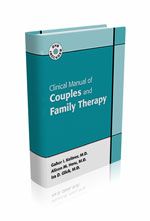Publication
Article
Psychiatric Times
Clinical Manual of Couples and Family Therapy
Author(s):
A well-written volume that provides evidence for the wisdom behind treatment of the family and/or involvement of the family when treating the patient.
With today’s emphasis on medical management, the role of family in caring for patients is often overlooked. The Clinical Manual of Couples and Family Therapy is a succinct, well-written volume that provides evidence for the wisdom behind treatment of the family and/or involvement of the family when treating the patient. It is a refreshing reminder of the art of therapy that drew many of us into the field of psychiatry in the first place. It reads easily and includes multiple tables for quick reference. The accompanying DVD with applications to specific disorders coincides with the book’s contents. The authors reveal that the art of therapy is most nota-ble in the setting of tasks and building of collaborative relationships.
From start to finish, this book fulfills its goal of “reestablishing the role of the psychiatrist as the leader of the treatment team.” The differences between providing care in combination with other providers versus providing integrated care as a sole provider are discussed. The book asserts the role of the psychiatrist as the one individual who may best provide multiple therapeutic options for the family. Any psychiatrist who has ever led treatment-planning conferences will appreciate this wisdom.
In the introduction, the authors express their aim of providing a generalized overview of the topic rather than focusing on specific details. Early chapters discuss healthy family function and the research that supports awareness of relational factors in mental health. A detailed explanation of the family assessment (or, the “mental status exam”) leads to a discussion of the biopsychosocial formulation to guide therapy. After a brief description of family therapy models, the authors elaborate on problem-centered systems therapy.
The chapter titled “Special Situations” deserves recognition because it stresses the importance of the therapeutic relationship and cultural sensitivity. A particular strength of this section is the emphasis on is-sues that surround domestic vio-lence and abuse.
While the third chapter provides a helpful review of current research on family factors in medical and psychiatric issues, it can be confusing and disorganized-and the most recent research is already 4 years old. Some chapters are repetitive and may be less rewarding than others.
For those who wish to study family therapy in depth, the book contains a detailed explanation of the McMaster model, with an introduction of the 6 dimensions of family function. Multiple examples in the chapters on assessment, formulation, and therapy are provided. The authors do not assume all their readers are family therapists, but they promote the idea that aware-ness of family therapy techniques is beneficial to every psychiatrist working with patients and their families.
In many ways, the Clinical Manual of Couples and Family Therapyspeaks to educators working with residents. It emphasizes not only the importance of training but also the modeling of skills of working with families. By following the biopsychosocial formulation as a method of promoting integration, it provides sound advice for educators working with residents.
Overall, this book is recommended for all practitioners. It succeeds as a useful, well-written testimony to the importance of involving families in mental health treatment. The family system, the book argues, remains the primary support system for our patients, and in order to provide good care for our patients, the family must be acknowledged and understood.







